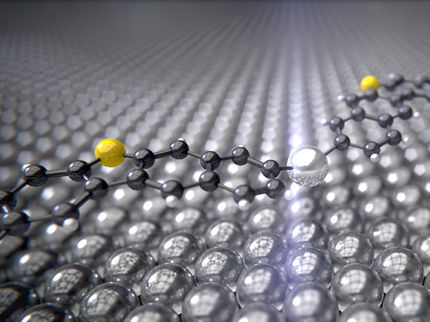Scientists capture electron transfer image in electrocatalysis process
In-situ electrochemical imaging method with nanoscale spatial resolution combined atomic force microscopy and scanning electrochemical imaging
The involvement between electron transfer (ET) and catalytic reaction at electrocatalyst surface makes electrochemical process challenging to understand and control. How to experimentally determine ET process occurring at nanoscale is important to understand the overall electrochemical reaction process at active sites.

Scientists capture electron transfer image in electrocatalysis process
DICP
Recently, a research group led by Prof. LI Can and Prof. FAN Fengtao from the Dalian Institute of Chemical Physics (DICP) of the Chinese Academy of Sciences (CAS) captured the electron transfer imaging in electrocatalysis process.
The researchers established an in-situ electrochemical imaging method with nanoscale spatial resolution, which combined atomic force microscopy and scanning electrochemical imaging. This method can realize the three-dimensional movement of the scanning nanoprobe to map the local distribution of the generated outer-spherical electron transfer molecules and the catalytic product molecules.
The visual electron transfer images on metal nanoplates directly demonstrated that the electron transfer process at nanoscale presented a site-dependent heterogeneity.
Moreover, to decouple the interference of the mass transfer effect on the electron transfer, the researchers conducted a series of elaborate experiments and complex mathematical modeling to extract the rate constant and internal potential difference. They found that the relationship between the interfacial inner potential difference and the rate constant followed a linear fashion.
This work realizes the in-situ observation of electron transfer process and catalytic reaction in the electrochemical reaction, and provides new ideas for the development of in-situ imaging characterization method and the detection of the mechanism of the electrocatalytic reactions.
"This is a new milestone of the scanning electrochemical probe techniques, making it possible to discover the structure-performance relation of nanocatalyst from the bottom of physical and chemical principles," commented by one of the reviewers.
Original publication
Other news from the department science

Get the analytics and lab tech industry in your inbox
By submitting this form you agree that LUMITOS AG will send you the newsletter(s) selected above by email. Your data will not be passed on to third parties. Your data will be stored and processed in accordance with our data protection regulations. LUMITOS may contact you by email for the purpose of advertising or market and opinion surveys. You can revoke your consent at any time without giving reasons to LUMITOS AG, Ernst-Augustin-Str. 2, 12489 Berlin, Germany or by e-mail at revoke@lumitos.com with effect for the future. In addition, each email contains a link to unsubscribe from the corresponding newsletter.


















































